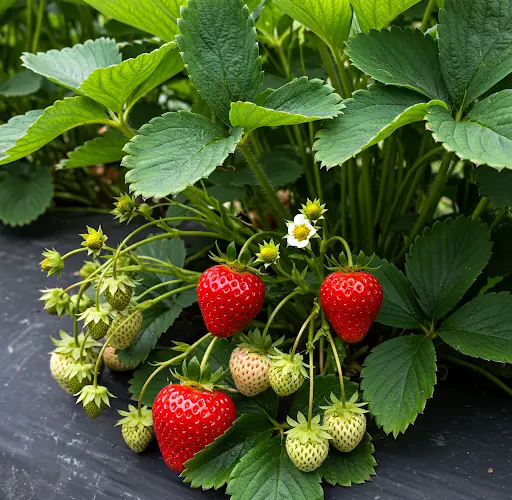The Secret to Consistent Strawberry Harvesting: Growing Tips for Beginners
Strawberries are a favorite fruit for many gardeners due to their sweet, juicy flavor and versatility in the kitchen. However, achieving a consistent and abundant harvest can be challenging, especially for beginners. The good news is that with the right techniques and proper care, you can enjoy fresh strawberries throughout the growing season. This guide will walk you through the essential tips for growing strawberries successfully, from selecting the right varieties to maintaining healthy plants and maximizing yield.
Choosing the Right Strawberry Varieties
One of the most important factors in achieving a continuous strawberry harvest is selecting the right type of strawberry plants. There are three main categories to consider:
1. June-Bearing Strawberries
These strawberries produce one large crop per year, typically in late spring or early summer. While they offer a bountiful harvest, they do not provide fruit throughout the season.
2. Everbearing Strawberries
Everbearing strawberries produce two to three harvests per year—once in early summer, again in late summer, and sometimes in early fall. These are ideal for those looking for multiple harvests but not a continuous supply.
3. Day-Neutral Strawberries
Day-neutral strawberries are the best choice for a consistent harvest, as they produce fruit throughout the growing season as long as temperatures remain between 35°F and 85°F (2°C to 29°C). They are an excellent option for beginners who want fresh strawberries all season long.
Preparing the Soil for Optimal Growth
Strawberries thrive in well-draining, nutrient-rich soil with a slightly acidic pH between 5.5 and 6.8. To create the perfect growing environment:
- Work organic matter such as compost or aged manure into the soil before planting.
- Ensure proper drainage by using raised beds or mounded rows if the soil is heavy or clay-like.
- Avoid planting strawberries in areas where tomatoes, peppers, eggplants, or potatoes have grown recently, as they can leave behind diseases harmful to strawberries.
Planting Your Strawberries
Proper planting techniques are key to healthy, productive strawberry plants:
- Spacing: Space plants 12-18 inches apart in rows that are 2-3 feet apart to allow good air circulation.
- Planting depth: Ensure the crown (where the leaves emerge) is at soil level—too deep, and the plant may rot; too shallow, and it may dry out.
- Mulching: Apply a layer of straw, pine needles, or wood chips around the plants to retain moisture, suppress weeds, and keep the berries clean.
Essential Care Tips for a Continuous Harvest
To maintain healthy plants and ensure a consistent supply of strawberries, follow these essential care practices:
1. Watering
Strawberries require regular watering, especially during fruiting periods. Keep the soil consistently moist but not waterlogged. Aim for about 1-2 inches of water per week.
2. Fertilizing
Strawberries benefit from balanced fertilization. Apply a balanced fertilizer (such as 10-10-10) in early spring and again after the first harvest to encourage continuous fruiting.
3. Pruning Runners
Strawberry plants produce runners (long stems that create new plants). While these can be useful for propagating new plants, removing most runners directs energy into fruit production, leading to larger and more frequent harvests.
4. Pest and Disease Management
Common pests such as aphids, slugs, and birds can reduce your strawberry yield. Protect your plants by:
- Using row covers or netting to keep birds away.
- Applying diatomaceous earth or organic pest control methods to deter insects and slugs.
- Rotating crops and ensuring proper spacing to prevent fungal diseases like powdery mildew and gray mold.
5. Overwintering Strawberry Plants
For those growing strawberries in colder climates, protecting the plants in winter is crucial:
- After the first hard frost, cover plants with straw or mulch to insulate them.
- In early spring, remove most of the mulch but leave a thin layer to prevent weeds.
Maximizing Yield for a Continuous Harvest
To enjoy a steady supply of strawberries, use these techniques:
- Succession Planting: Stagger plantings of everbearing or day-neutral varieties at different times to extend the harvest.
- Container Growing: Growing strawberries in containers allows you to move them indoors during colder months, prolonging their fruiting season.
- Greenhouse or High Tunnel Growing: If possible, grow strawberries in a greenhouse or under row covers to extend the growing season and protect them from harsh weather conditions.
Harvesting Strawberries for the Best Flavor
To get the best taste and texture, harvest strawberries at their peak ripeness:
- Pick berries when they are fully red and firm.
- Harvest in the morning when the temperatures are cooler to retain freshness.
- Handle berries gently and store them in a cool place to extend shelf life.
Conclusion
Growing strawberries successfully and achieving a consistent harvest is possible with the right approach. By selecting the best varieties, preparing the soil properly, and following essential care practices, you can enjoy fresh strawberries throughout the growing season. Whether growing them in the ground, containers, or a greenhouse, these tips will help you maximize your strawberry yield and enjoy a delicious, homegrown supply year after year.



